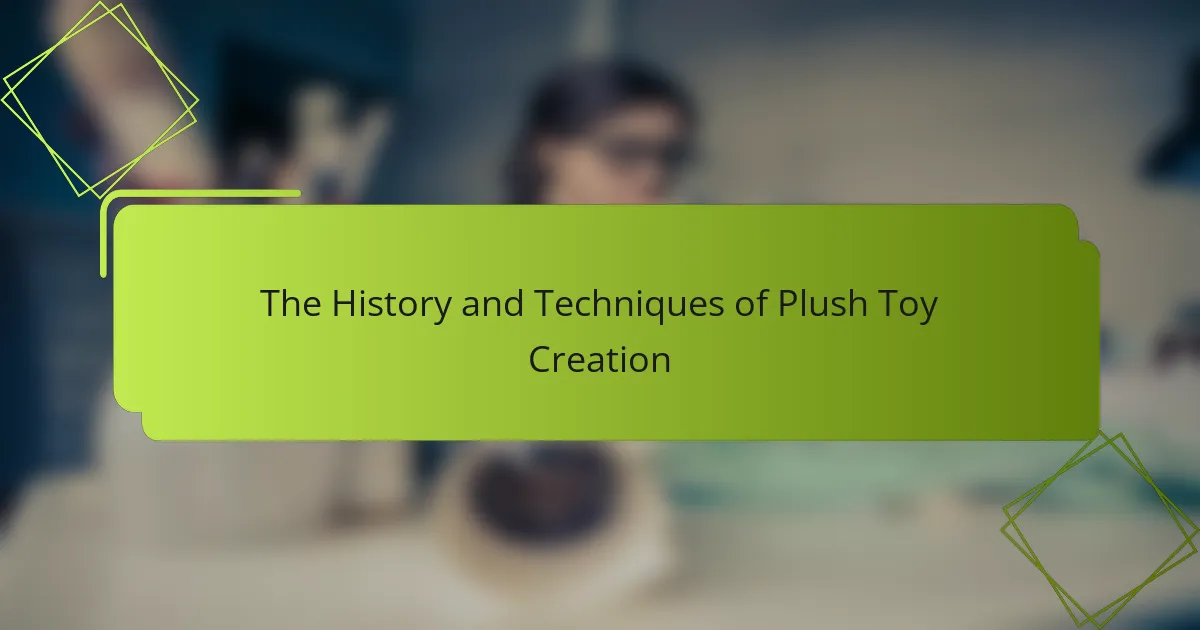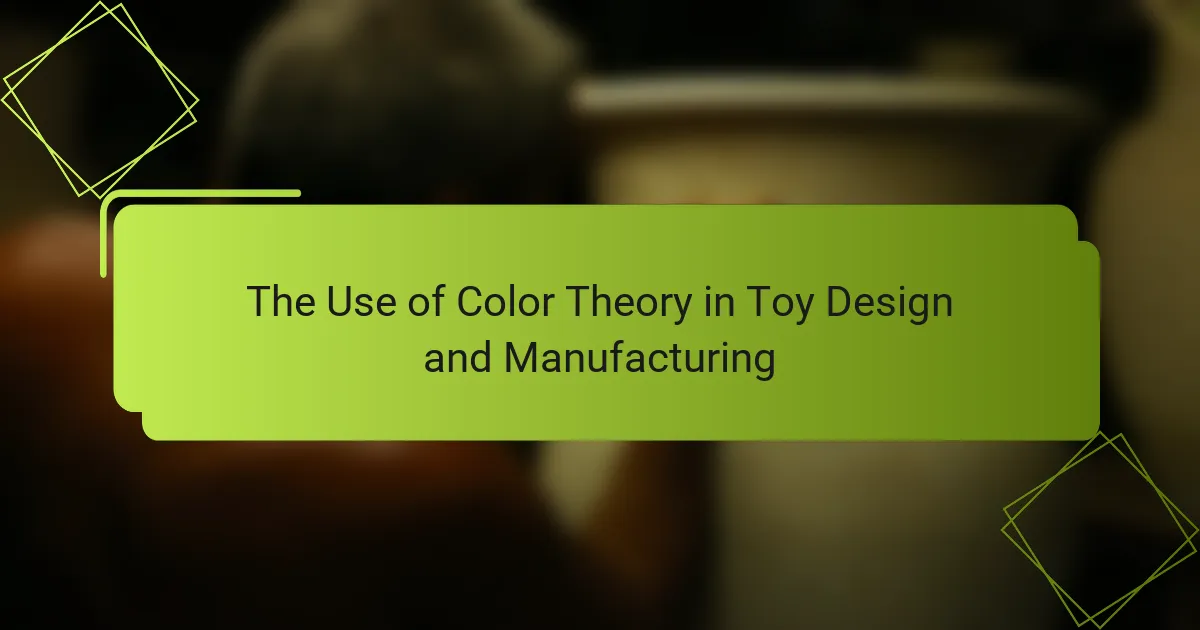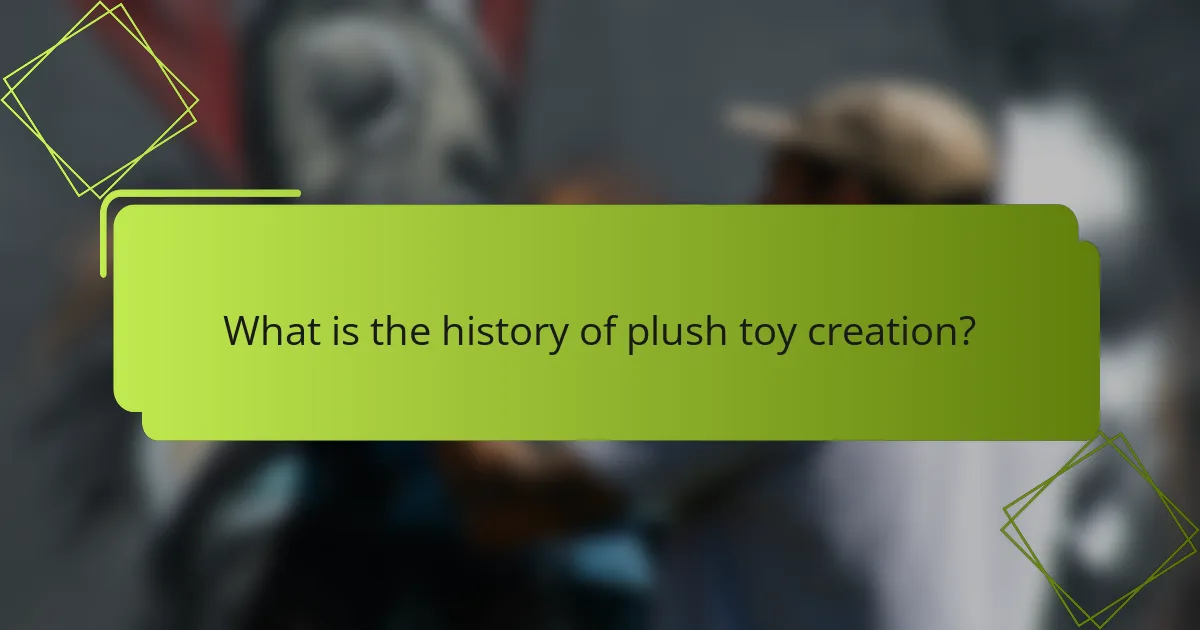
What is the history of plush toy creation?
Plush toys originated in the late 19th century. The first mass-produced plush toy was the teddy bear, created in 1902. Morris Michtom and his wife Rose invented it after President Theodore Roosevelt’s bear hunting trip. They founded the Ideal Novelty and Toy Company to manufacture these toys. Plush toys became popular in Europe shortly after. German company Steiff began producing high-quality stuffed animals in 1880. The introduction of new materials in the 20th century improved their softness and durability. By the 1950s, plush toys were a staple in children’s markets worldwide. Today, plush toys encompass a wide variety of designs and characters.
How did plush toys originate and evolve over time?
Plush toys originated in the late 19th century. The first commercially successful plush toy was created in Germany in 1880. This toy was a soft stuffed bear made from mohair and filled with wood shavings. The concept gained popularity in the United States with the introduction of the teddy bear in 1902. The teddy bear was inspired by a cartoon depicting President Theodore Roosevelt. Over time, plush toys evolved in design and materials. Synthetic fabrics became common in the mid-20th century. The introduction of polyester fiberfill in the 1950s allowed for softer and more durable toys. Today, plush toys come in various shapes, sizes, and characters, appealing to diverse audiences.
What were the earliest materials used in plush toy production?
The earliest materials used in plush toy production included cotton, wool, and felt. Cotton was commonly used for the outer fabric due to its softness and durability. Wool provided warmth and a unique texture, making it a popular choice as well. Felt, made from compressed fibers, was often used for detailing and embellishments. These materials were widely available and affordable in the early 20th century. Historical records indicate that these fabrics were favored for their comfort and ease of manipulation in crafting toys.
How did cultural influences shape plush toy designs?
Cultural influences significantly shaped plush toy designs by reflecting societal values and trends. For example, during the Victorian era, plush toys often represented animals and characters from literature, emphasizing imagination and storytelling. In the mid-20th century, the rise of television introduced characters like Mickey Mouse, influencing designs to be more cartoonish and relatable. Different cultures also contributed unique styles; Japanese kawaii culture popularized cute, oversized features in plush toys. Additionally, cultural events and holidays inspired seasonal designs, such as Halloween-themed plush toys. The global exchange of ideas led to diverse designs that cater to various cultural preferences, enhancing their appeal.
What significant milestones marked the development of plush toys?
The development of plush toys has several significant milestones. The first milestone was in the late 19th century with the introduction of the teddy bear. This toy was inspired by President Theodore Roosevelt’s bear hunting trip in 1902. The first mass-produced teddy bear was created by the Steiff company in Germany in 1903.
Another milestone occurred in the 1940s with the introduction of plush toys featuring character licensing. This included popular cartoon characters like Mickey Mouse. The 1980s saw a rise in collectible plush toys, notably with the launch of Beanie Babies in 1993.
In the 2000s, advancements in technology led to the creation of interactive plush toys. These toys could respond to touch and voice, enhancing the play experience. Today, plush toys continue to evolve with themes from movies, video games, and social media trends.
Which historical events influenced the popularity of plush toys?
The popularity of plush toys was influenced by several historical events. The Industrial Revolution in the 19th century led to mass production techniques. This made plush toys more affordable and accessible to families. The rise of children’s literature, such as “Winnie the Pooh,” also boosted demand. World War II saw a surge in toy production for comfort during difficult times. The post-war baby boom increased the market for children’s products. In the 1980s, the introduction of characters from television and movies further popularized plush toys. These events collectively contributed to the enduring appeal of plush toys across generations.
How did technology advancements impact plush toy manufacturing?
Technology advancements significantly transformed plush toy manufacturing. Automation in sewing and cutting processes increased production efficiency. Computer-aided design (CAD) software allowed for precise patterns and designs. Advanced materials improved durability and safety in plush toys. Digital printing technology enabled vibrant and detailed designs on fabrics. The rise of e-commerce expanded market reach for manufacturers. Robotics in assembly lines reduced labor costs and enhanced consistency. These advancements collectively contributed to a more innovative and competitive industry.
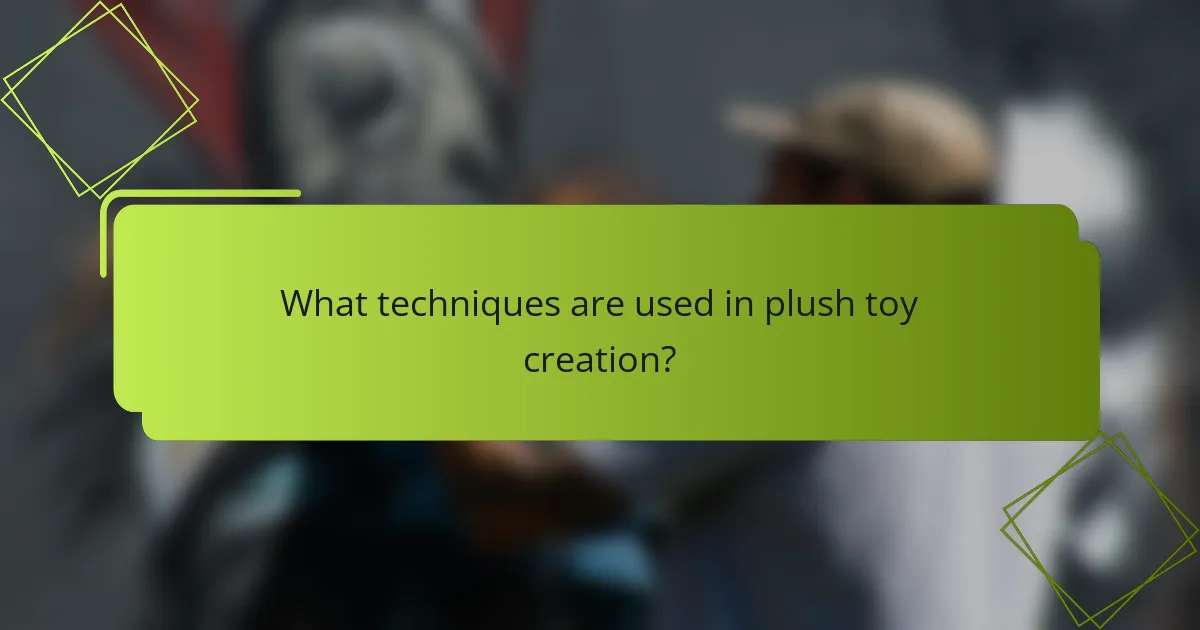
What techniques are used in plush toy creation?
Plush toy creation involves several techniques including cutting, sewing, stuffing, and finishing. Cutting is the first step where fabric pieces are shaped according to design patterns. Sewing joins the fabric pieces together, often using machine stitching for durability. Stuffing fills the toy with materials like polyester fiber or foam to provide softness. Finishing includes adding details such as eyes, noses, and other features. Each technique is essential for achieving the final plush toy’s look and feel. These methods have been refined over decades, ensuring quality and safety in plush toy production.
What are the primary methods of plush toy manufacturing?
The primary methods of plush toy manufacturing include cutting, sewing, stuffing, and finishing. Cutting involves shaping fabric pieces according to patterns. Sewing connects these pieces together, forming the toy’s structure. Stuffing fills the toy with materials like polyester fiber or cotton. Finishing adds details such as eyes, noses, and any embellishments. These methods ensure the plush toy is safe and appealing. Factories often use automated machines for efficiency in these processes. Manual labor may be involved for intricate designs or quality control. Each method contributes to the final product’s quality and durability.
How does the sewing technique vary across different plush toys?
Sewing techniques vary significantly across different plush toys. Each plush toy type employs unique methods based on design and materials. For example, traditional teddy bears often use a simple whip stitch for assembly. This technique creates a durable seam while allowing for easy stuffing. In contrast, character plush toys may utilize a combination of machine and hand sewing. This hybrid approach accommodates intricate designs and ensures precise detailing. Additionally, some plush toys incorporate techniques like appliqué for [censured] features. This method adds texture and visual interest. Overall, the choice of sewing technique reflects the toy’s intended use and aesthetic appeal.
What role does stuffing material play in plush toy quality?
Stuffing material significantly influences plush toy quality. It affects the toy’s softness, durability, and overall appearance. High-quality stuffing provides a plush feel, making the toy more appealing to children. Materials like polyester fiberfill are commonly used for their resilience and lightweight nature. In contrast, low-quality stuffing may lead to flatness and loss of shape over time. The choice of stuffing also impacts safety; non-toxic materials are essential for children’s toys. Studies show that plush toys with quality stuffing maintain their shape and softness longer. This ensures a better user experience and satisfaction.
What innovative techniques have emerged in plush toy design?
Innovative techniques in plush toy design include 3D printing, smart technology integration, and sustainable materials. 3D printing allows for complex shapes and customization. This technique reduces production time and enables detailed designs. Smart technology integration incorporates features like sound and motion sensors. These enhancements create interactive experiences for users. Sustainable materials focus on eco-friendly fabrics and stuffing. This approach addresses environmental concerns in manufacturing. Each of these techniques represents a shift towards modernized, user-centric design in the plush toy industry.
How has 3D printing changed the landscape of plush toy creation?
3D printing has revolutionized plush toy creation by enabling rapid prototyping and customization. This technology allows designers to create intricate and unique toy shapes that were previously difficult to achieve. It significantly reduces production time, allowing for quicker turnaround from concept to finished product. Additionally, 3D printing facilitates the production of small batches, catering to niche markets and individual preferences. The ability to produce on-demand reduces waste associated with overproduction. According to a report by Wohlers Associates, the 3D printing industry is projected to grow to over $35 billion by 2024, indicating its increasing influence across various sectors, including toy manufacturing.
What are the benefits of using sustainable materials in plush toy production?
Using sustainable materials in plush toy production reduces environmental impact. Sustainable materials often come from renewable resources. This helps conserve natural habitats and biodiversity. Additionally, these materials are typically biodegradable or recyclable. This reduces waste in landfills compared to conventional materials.
Using organic cotton, for example, uses less water and avoids harmful pesticides. According to the Textile Exchange, organic cotton production uses 91% less water than conventional cotton. Sustainable materials can also enhance brand reputation. Consumers increasingly prefer eco-friendly products. This can lead to increased sales and customer loyalty. Overall, sustainable materials contribute to a healthier planet and a positive brand image.
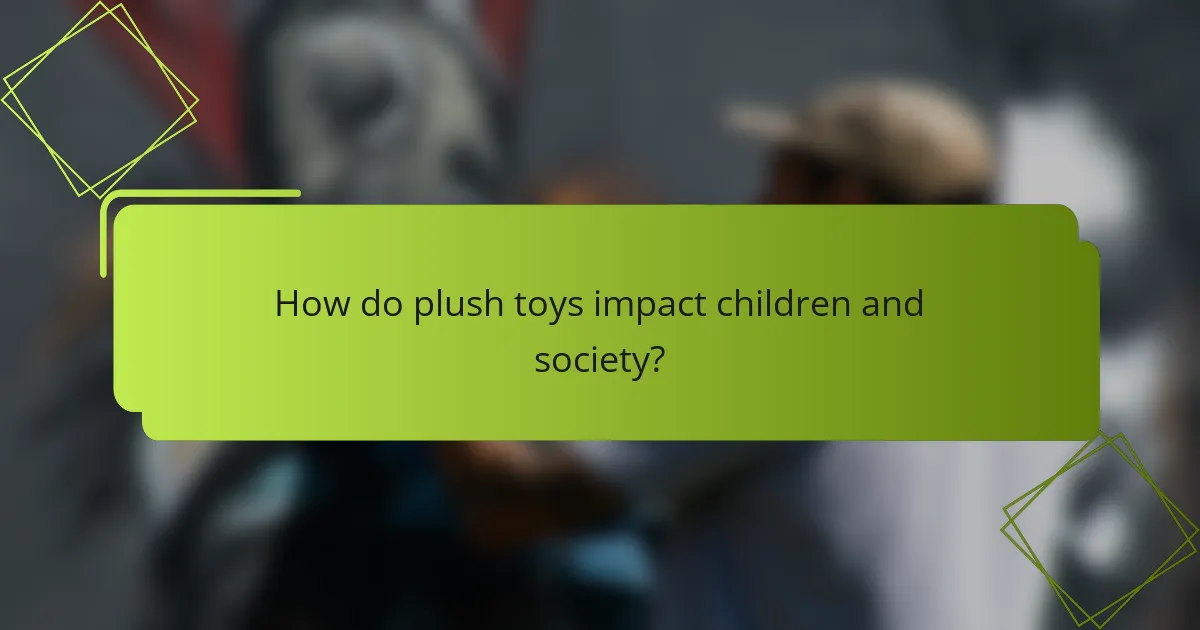
How do plush toys impact children and society?
Plush toys positively impact children and society by providing emotional support and fostering imagination. They serve as comfort objects, helping children cope with anxiety and stress. Research indicates that 70% of children feel more secure when they have a plush toy. Plush toys also encourage imaginative play, which is crucial for cognitive development. Engaging with these toys helps children develop social skills by practicing empathy and nurturing behavior. Additionally, plush toys contribute to the toy industry, generating significant economic activity. In 2020, the global plush toy market was valued at approximately $7.3 billion. Overall, plush toys play a vital role in child development and societal well-being.
What psychological benefits do plush toys provide to children?
Plush toys provide significant psychological benefits to children. They offer comfort and security, helping to reduce anxiety and fear. Children often use plush toys as a source of emotional support during stressful situations. Research indicates that hugging a stuffed animal can lead to lower cortisol levels, which are associated with stress. Plush toys also encourage imaginative play, fostering creativity and problem-solving skills. Additionally, they can serve as a transitional object, aiding in the adjustment to new experiences such as starting school. This attachment can enhance a child’s sense of identity and self-esteem. Overall, plush toys play a vital role in emotional development and psychological well-being in children.
How do plush toys aid in emotional development?
Plush toys aid in emotional development by providing comfort and security to children. They serve as companions that help children express their feelings. Through imaginative play, children can explore emotions such as happiness, sadness, and fear. Plush toys also facilitate social skills by encouraging sharing and empathy during play. Research indicates that children often project their emotions onto these toys. This projection helps them process complex feelings in a safe environment. According to a study published in the journal “Child Development,” children who engage with plush toys show improved emotional regulation. This interaction fosters a sense of belonging and reduces anxiety.
What role do plush toys play in imaginative play?
Plush toys serve as essential tools for imaginative play. They provide children with a safe and comforting companion. This companionship encourages creativity and storytelling. Children often assign personalities and roles to their plush toys. This process enhances social skills and emotional expression. Research indicates that imaginative play fosters cognitive development. A study by Ginsburg (2007) highlights the importance of play in childhood learning. Plush toys facilitate scenarios that help children process experiences. They can also represent various characters, enhancing narrative skills.
How have plush toys influenced popular culture?
Plush toys have significantly influenced popular culture by becoming iconic symbols in various media. They appear in movies, television shows, and video games, often representing comfort and nostalgia. Characters like Mickey Mouse and Winnie the Pooh originated as plush toys and became cultural icons. Their presence in merchandising has shaped consumer behavior, contributing to the rise of character branding. Plush toys also foster emotional connections, often serving as companions for children and adults alike. This emotional attachment has led to their integration into social media, where users share experiences related to their plush toys. The phenomenon of “plush toy therapy” highlights their role in mental health and well-being. Overall, plush toys have transcended their original purpose, embedding themselves into the fabric of popular culture.
Which iconic plush toys have become cultural symbols?
Iconic plush toys that have become cultural symbols include Mickey Mouse, Winnie the Pooh, and Paddington Bear. Mickey Mouse, created by Walt Disney in 1928, represents joy and childhood. Winnie the Pooh, introduced by A.A. Milne in 1926, symbolizes friendship and adventure. Paddington Bear, originating from children’s literature in 1958, embodies kindness and curiosity. These toys have transcended their original purpose and are recognized worldwide. Their influence extends into various media, merchandise, and cultural references, solidifying their status as cultural icons.
How do media and entertainment shape plush toy trends?
Media and entertainment significantly influence plush toy trends. Popular movies and television shows often introduce characters that become iconic. These characters drive consumer interest in plush toys. For instance, the success of animated films leads to the creation of plush versions of beloved characters. Merchandise tied to franchises like Disney and Pixar generates substantial sales. Additionally, social media platforms amplify trends through influencer marketing. Viral videos showcasing plush toys can lead to sudden spikes in demand. Historical data shows that toy sales often correlate with media releases. This demonstrates the powerful link between entertainment and plush toy popularity.
What best practices should be followed in plush toy creation?
Best practices in plush toy creation include using safe, non-toxic materials. Safety standards, such as ASTM F963, ensure toys are safe for children. Employing high-quality stitching prevents seams from coming apart. Using durable fabrics enhances longevity and withstands wear. Ensuring proper filling materials maintains shape and comfort. Testing for choking hazards is critical for small parts. Following age-appropriate design guidelines ensures toys are suitable for intended users. Regular quality control checks help maintain production standards.
How can creators ensure safety and quality in plush toys?
Creators can ensure safety and quality in plush toys by adhering to strict safety standards. They should use non-toxic materials that meet regulatory guidelines. Testing for choking hazards and ensuring secure stitching is essential. Additionally, following guidelines from organizations like ASTM International can enhance safety. Regular quality control checks during production help maintain consistent standards. Manufacturers should also provide clear labeling for age appropriateness. Compliance with these practices reduces risks and increases consumer trust in plush toys.
What tips can enhance the appeal of plush toy designs?
To enhance the appeal of plush toy designs, focus on unique character development. Creating memorable and relatable characters increases emotional connection. Use vibrant colors to attract attention and evoke positive feelings. Textures play a crucial role; soft, tactile materials enhance the sensory experience. Incorporating interactive elements, like sound or movement, can engage children and parents alike. Customization options, such as personal names or outfits, add a personal touch that appeals to buyers. Research shows that toys with storytelling elements are more likely to capture interest and promote imaginative play.
The main entity of the article is plush toys, which have a rich history dating back to the late 19th century. The article covers the origins of plush toys, highlighting key milestones such as the creation of the teddy bear and the influence of cultural trends on design. It details the materials and techniques used in plush toy manufacturing, including advancements in technology and sustainable practices. Additionally, the article explores the psychological benefits of plush toys for children, their impact on popular culture, and best practices for ensuring safety and quality in their production.
